Quantitative Evaluation of Ecosystem Health in a Karst Area of South China
Abstract
:1. Introduction
2. Materials and Methods
2.1. Study Area
2.2. Data Source
2.3. Design and Calculation of KRD Ecosystem Health Index (K)
2.4. Diagnosis Method in Grid GIS
- (1)
- Built a diagnosis indicator system of KRD ecosystem health;
- (2)
- Prepared a thematic map of HDA for each of the diagnosis indicators. Each diagnosis indicator represents a layer and each thematic map (layer) corresponds to an indicator in the attribute table;
- (3)
- Assigned all diagnosis indicators with corresponding value according to the assignment table;
- (4)
- Determined weight of each diagnostic indicator;
- (5)
- Gridded the layers by first using the “projections” tool in ArcGIS to convert the multi-source data into the same projection coordinates. Then, using the “polygon to raster” tool, all of the indicator data were converted from vector data into raster data. Third, a resolution grid of 5 m × 5 m was chosen as the basic unit of calculation;
- (6)
- Stacked the layers and calculated the layers using the “calculator raster” tool to calculate the comprehensive index of ecosystem health (K);
- (7)
- Used the “reclassify” tool to classify the maps of Ecosystem Health Index (K) according to classification table; and
- (8)
- Analyzed the data.
2.4.1. Diagnosis Indicator System of KRD Ecosystem Health
2.4.2. Assignment of Diagnosis Indicator
2.4.3. Determination of Weights
3. Results
3.1. Temporal Dynamic Analysis of KRD Ecosystem Health
3.2. Spatial Distribution of KRD Ecosystem Health
4. Discussion
5. Conclusions
Acknowledgments
Author Contributions
Conflicts of Interest
References
- Cai, Y. Preliminary research on ecological reconstruction in Karst mountain poverty areas of southwest China. Adv. Earth Sci. 1996, 11, 602–606. [Google Scholar]
- Sweeting, M.M. Karst in China: Its Geomorphology and Environment; Springer: Berlin, Germany, 1995. [Google Scholar]
- Yuan, D.X. Aspects on the new round land and resource survey in Karst rock desertification areas of south China. Carsol. Sin. 2000, 19, 103–108. [Google Scholar]
- Xiong, K.N.; Chen, Y.B.; Chen, H. Touch Graphite and Turn it into Diamond—The Ecological Techniques and Models of Control-Ling of Karst Rocky Desertification in GuiZhou Province; Guizhou Science & Technology Publishing House: Guiyang, China, 2011. [Google Scholar]
- Wang, S.J.; Liu, Q.M.; Zhang, D.F. Karst rocky desertification in Southwestern China: Geomorphology, landuse, impact and rehabilitation. Land Degrad. Dev. 2004, 15, 115–121. [Google Scholar] [CrossRef]
- Wang, S.J.; Li, Y.B. Problems and development trends about researches on Karst rocky desertification. Adv. Earth Sci. 2007, 22, 573–582. [Google Scholar]
- Sahaeffer, D.J.; Henricks, E.E.; Kerster, H.W. Ecosystem health: Measuring ecosystem health. Environ. Manag. 1988, 12, 445–455. [Google Scholar] [CrossRef]
- Rapport, D.J.; Costanza, R.; Michael, A.J. Assessing ecosystem health. Trends Ecol. Evol. 1998, 13, 397–402. [Google Scholar]
- Lackey, R.T. Values, Policy, and Ecosystem Health. Bioscience 2001, 51, 437–443. [Google Scholar] [CrossRef]
- Costanzia, R.; Norton, B.G.; Haskell, B.D. Ecosystem Health: New Goals for Environmental Management; Island Press: Washington, DC, USA; Covelo, CA, USA, 1992; pp. 239–256. [Google Scholar]
- Jørgensen, S.E. Exergy and ecological buffer capacities as measures of ecosystem health. Ecosyst. Health 1995, 1, 150–160. [Google Scholar]
- Yuan, F.; Zhang, X.Y.; Liang, J. Assessment indicators system of forest ecosystem health based on the disturbance in Wangqing forestry. Acta Ecol. Sin. 2013, 33, 3722–3731. [Google Scholar] [CrossRef]
- Fisher, M.C.; Henk, D.A.; Briggs, C.J.; Brownstein, J.S.; Madoff, L.C.; Mccraw, S.L. Emerging fungal threats to animal, plant and ecosystem health. Nature 2012, 484, 184–194. [Google Scholar] [CrossRef] [PubMed]
- Ogden, J.C.; Baldwina, J.D.; Bass, O.L.; Browder, J.A.; Cook, M.I.; Frederick, P.C. Waterbirds as indicators of ecosystem health in the coastal marine habitats of southern Florida: 1. Selection and justification for a suite of indicator species. Ecol. Indic. 2014, 44, 148–163. [Google Scholar] [CrossRef]
- Horwitz, P.; Finlayson, C.M. Wetlands as settings for human health: Incorporating ecosystem services and health impact assessment into water resource management. Bioscience 2011, 61, 678–688. [Google Scholar] [CrossRef]
- Li, C.; Ye, C.; Zhao, X.; Wang, Q.; Chen, X.; Kong, X.; Lu, S.; Xu, D.; Chen, Q. The ecosystem health assessment of the littoral zone of Lake Taihu. Acta Ecol. Sin. 2012, 32, 3806–3815. [Google Scholar]
- Liao, J.; Cao, X.; Jie, W.; Yi, H. Basin-scale aquatic ecosystem health assessment with composite indices of chemistry and aquatic biota: A study of Dianchi Lake. Acta Sci. Circumstantiae 2014, 34, 1845–1852. [Google Scholar]
- Zhu, W.; Cao, G.; Li, Y.; Xu, W.; Shi, M.; Qin, L. Research on the health assessment of river ecosystem in the area of Tumen River Basin. Acta Ecol. Sin. 2014, 34, 3969–3977. [Google Scholar]
- Tett, P.; Gowen, R.J.; Painting, S.J.; Elliott, M.; Forster, R.; Mills, D.K.; Bresnan, E.; Capuzzo, E.; Fernandes, T.F.; Foden, J.; et al. Framework for understanding marine ecosystem health. Mar. Ecol. Prog. Ser. 2013, 494, 1–27. [Google Scholar] [CrossRef]
- Kim, Y.O.; Xu, F.L. Marine ecosystem health assessments in Korean coastal waters. Ocean Sci. J. 2014, 49, 249–250. [Google Scholar] [CrossRef]
- Jin, S.L.; Huang, Y.Z. A review on rare earth elements in farmland ecosystem. Acta Ecol. Sin. 2013, 33, 4836–4845. [Google Scholar]
- Tang, D.; Zou, X.; Liu, X.; Liu, P.; Zhamangulova, N.; Xu, X.; Zhao, Y. Integrated ecosystem health assessment based on eco-energy theory: A case study of the Jiangsu coastal area. Ecol. Indic. 2015, 48, 107–119. [Google Scholar] [CrossRef]
- Jia, R.; Liu, X.; Zhao, X.; Song, S. Assessment of ecosystem health in Shenfu mining area. Coal Geol. Explor. 2011, 39, 46–51. [Google Scholar]
- Li, Y.; Dong, L. Assessment and forecast of Beijing and Shanghai’s urban ecosystem health. Sci. Total Environ. 2014, 487, 154–163. [Google Scholar] [CrossRef] [PubMed]
- Li, S.-J.; Luo, X.; Hu, Y.-N. Ecological Health Assessment of Shijiazhang Urban Ecosystem in Fasting Urbanizing City. Res. Soil Water Conserv. 2012, 19, 245–249. [Google Scholar]
- Liu, H. Ecosystem Health Assessment of Guangzhou City. Adv. Mater. Res. 2013, 726, 997–1000. [Google Scholar] [CrossRef]
- Parise, M.; Waele, J.D.; Gutierrez, F. Current perspectives on the environmental impacts and hazards in Karst. Environ. Geol. 2009, 58, 235–237. [Google Scholar] [CrossRef]
- Cao, H.; Su, W.C. Studies on ecosystem health evaluation based on fuzzy mathematics method in Karst areas. Res. Soil Water Conserv. 2009, 16, 148–154. [Google Scholar]
- Zhang, F.T.; Su, W.C.; Zhao, W.Q.; Liang, Y.H.; Shao, J.X. Ecosystem health assessment in mountainous areas of Karst plateau based on ecological footprint model. Bull. Soil Water Conserv. 2011, 31, 256–261. [Google Scholar]
- Kawakubo, F.S.; Morato, R.G.; Luchiari, A. Use of fraction imagery, segmentation and masking techniques to classify land-use and land-cover types in the Brazilian Amazon. Int. J. Remote Sens. 2013, 34, 5452–5467. [Google Scholar] [CrossRef]
- Pu, R.; Gong, P.; Tian, Y.; Miao, X.; Carruthers, R.I.; Anderson, G.L. Using classification and NDVI differencing methods for monitoring sparse vegetation coverage: A case study of saltcedar in Nevada, USA. Int. J. Remote Sens. 2007, 29, 3987–4011. [Google Scholar] [CrossRef]
- Ramezani, H. A Note on the Normalized Definition of Shannon’s Diversity Index in Landscape Pattern Analysis. Environ. Nat. Resour. Res. 2012, 2, 54–60. [Google Scholar] [CrossRef]
- Ministry of Water Resources of the People’s Republic of China (MWR). Techniques Standard for Comprehensive Control of Soil Erosion and Water Loss in Karst Region; China Water Conservancy and Hydropower Press: Beijing, China, 2010.
- Xiong, K.N.; Zhou, Z.F. Typical Study on Karst Rock Desertification RS and GIS—A Case Study of Guizhou Province; Geology Press: Beijing, China, 2002. [Google Scholar]
- Wei, X.D.; Zhou, Z.F.; Wang, Y.Y. Research on the Karst ecological security based on gridding GIS. J. Mt. Sci. 2012, 30, 681–687. [Google Scholar]
- Rombouts, I.; Beaugrand, G.; Artigas, L.F.; Dauvin, J.C.; Gevaert, F.; Goberville, E. Evaluating marine ecosystem health: Case studies of indicators using direct observations and modeling methods. Ecol. Indic. 2013, 24, 353–365. [Google Scholar] [CrossRef]
- Baek, S.H.; Son, M.; Kim, D.; Choi, H.W.; Kim, Y.O. Assessing the ecosystem health status of Korea Gwangyang and Jinhae bays based on a planktonic index of biotic integrity (P-IBI). Ocean Sci. J. 2014, 49, 291–311. [Google Scholar] [CrossRef]
- Wang, D.L.; Zhu, S.Q.; Huang, B.L. Preliminary study on types and desertification in Guizhou Province, quantitative assessment of Karst rocky China. Acta Ecol. Sin. 2005, 25, 1057–1063. [Google Scholar]
- Mageau, M.T.; Costanza, R.; Ulanowicz, R.E. The development and initial testing a quantitative assessment of ecosystem health. Acta Psychiatr. Scand. 1995, 1, 201–213. [Google Scholar]
- Flannery, T.F. The Future Eaters: An Ecological History of the Australasian Lands and People; Reed Press: Melbourne, Australia, 1994. [Google Scholar]
- Redman, C.L. Human Impact on Ancient Environments; University of Arizona Press: Tucson, AZ, USA, 1999. [Google Scholar]
- Diamond, J. Collapse: How Societies Choose to Fail or Succeed; Viking Penguin: New York, NY, USA, 2005. [Google Scholar]
- Ji, X.; Luo, Y. A Precipitation Estimation Method and Its Application in Hydrologic Simulation in Data-scarce High Mountain Area. J. Irrig. Drain. 2011, 30, 103–106. [Google Scholar]
- Fei, M.C.; Wen, M.J.; Aosaier, B. Quantitative Assessment of Vegetation Coverage Factor in USLE Model Using Remote Sensing Data. Bull. Soil Water Conserv. 2001, 21, 6–9. [Google Scholar]
- Abson, D.J.; Fraser, E.D.; Benton, T.G. Landscape diversity and the resilience of agricultural returns: A portfolio analysis of land-use patterns and economic returns from lowland agriculture. Agric. Food Secur. 2013, 2, 1–15. [Google Scholar] [CrossRef]
- Chen, A.L.; Zhu, B.Q.; Chen, L.D.; Wu, Y.H.; Sun, R.H. Dynamic changes of landscape pattern and eco-disturbance degree in Shuangtai estuary wet land of Liaoning province, China. Chin. J. Appl. Ecol. 2010, 21, 1120–1128. [Google Scholar]
- Lu, L.; Zhan, Y.; Ye, Y.; Chen, J. Regional ecosystem health assessment based on land use pattern: A case of study of Zhoushan Island. Acta Ecol. Sin. 2010, 30, 245–252. [Google Scholar]
- Su, X.Y.; Wu, J.Y.; Zhang, H.J.; Li, Z.Q.; Sun, X.H.; Deng, Y. Assessment of grain security in China by using the AHP and DST methods. J. Agric. Sci. Technol. 2012, 14, 715–726. [Google Scholar]
- Huang, Q.H.; Cai, Y.L. Spatial pattern of Karst rock desertification in the Middle of Guizhou Province, Southwestern China. Environ. Geol. 2007, 52, 1325–1330. [Google Scholar] [CrossRef]
- Su, W.C.; Yang, H.; Li., Q.; Guo, Y. Rocky land desertification and its controlling measurements in the Karst mountainous region, Southwest of China. Chin. J. Soil Sci. 2006, 37, 446–450. [Google Scholar]
- Wu, J.G.; Chang, X.X. Assessment of the Health of Desert Ecosystem. J. Desert Res. 2005, 25, 604–611. [Google Scholar]
- Styers, D.M.; Chappelka, A.H.; Marzen, L.J.; Somer, G.L. Developing a land-cover classification to select indicators of forest ecosystem health in a rapidly urbanizing landscape. Landsc. Urban Plan. 2010, 94, 158–165. [Google Scholar] [CrossRef]
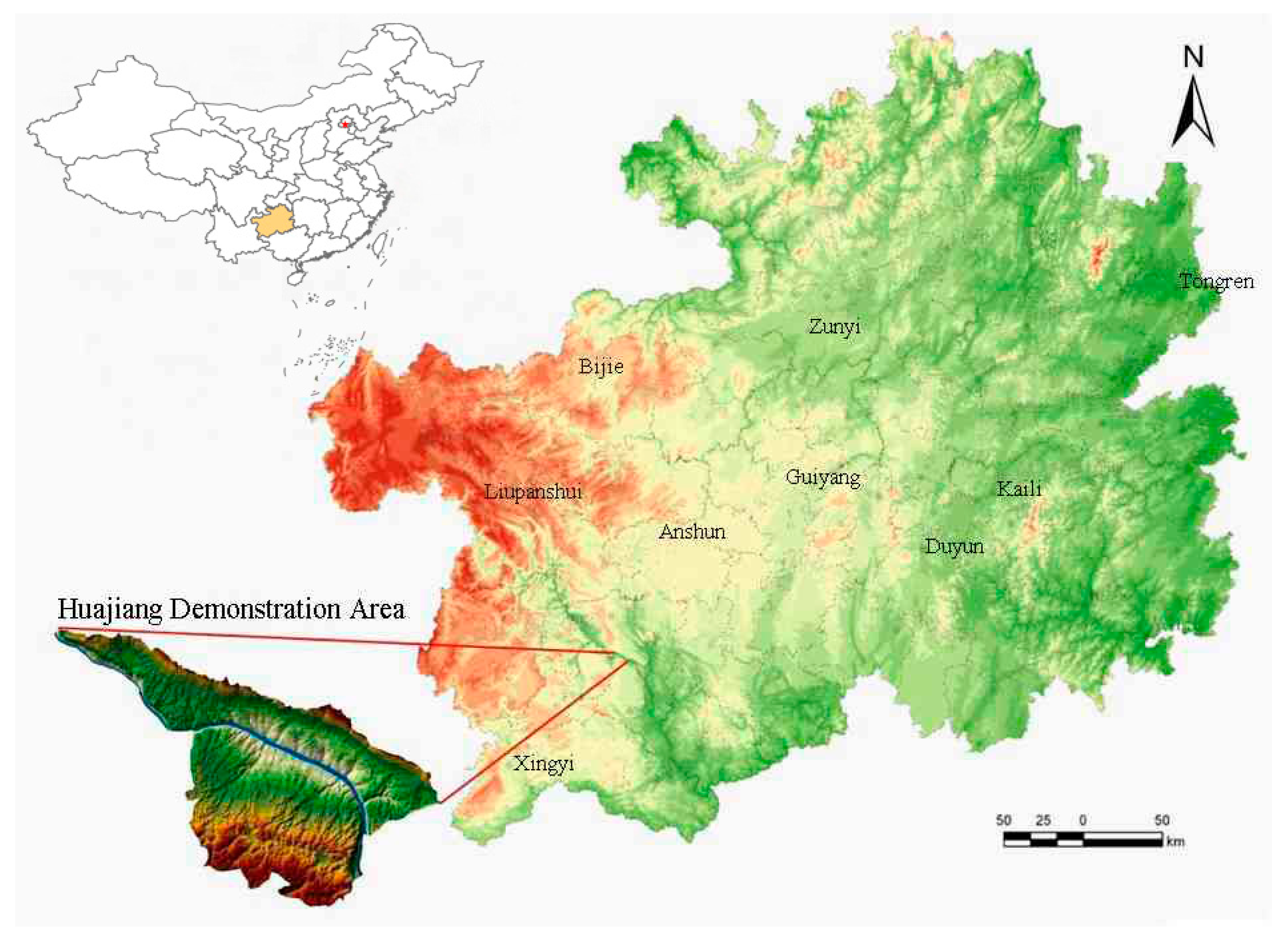
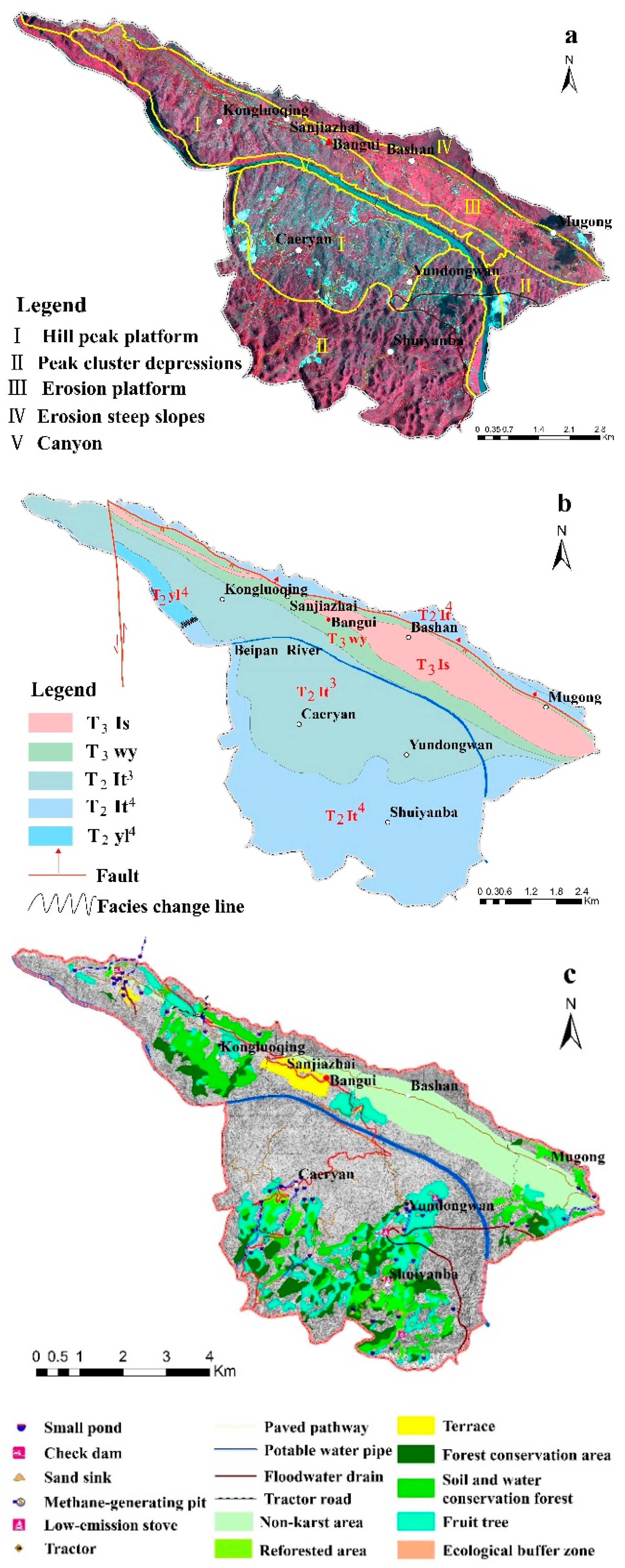
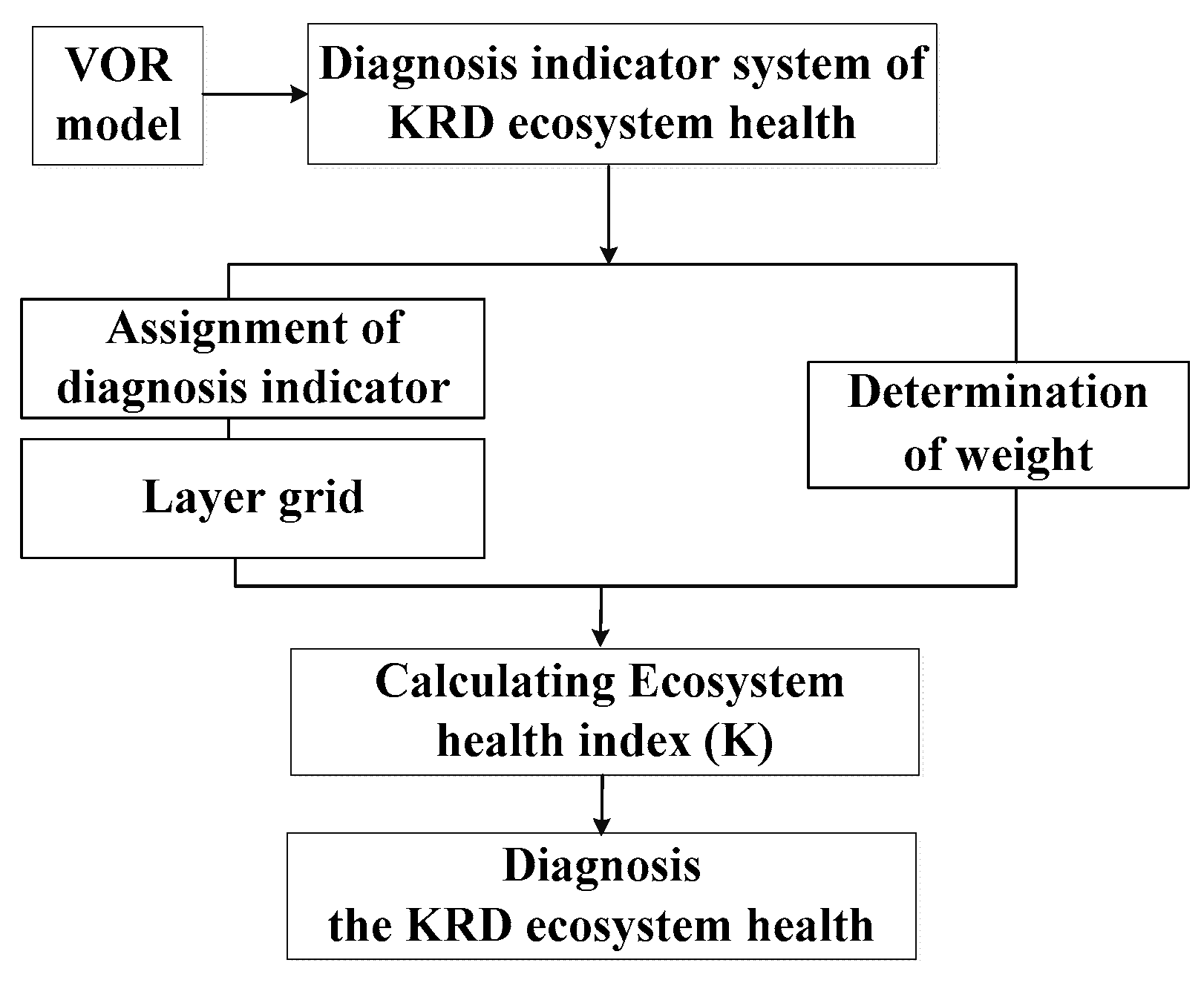
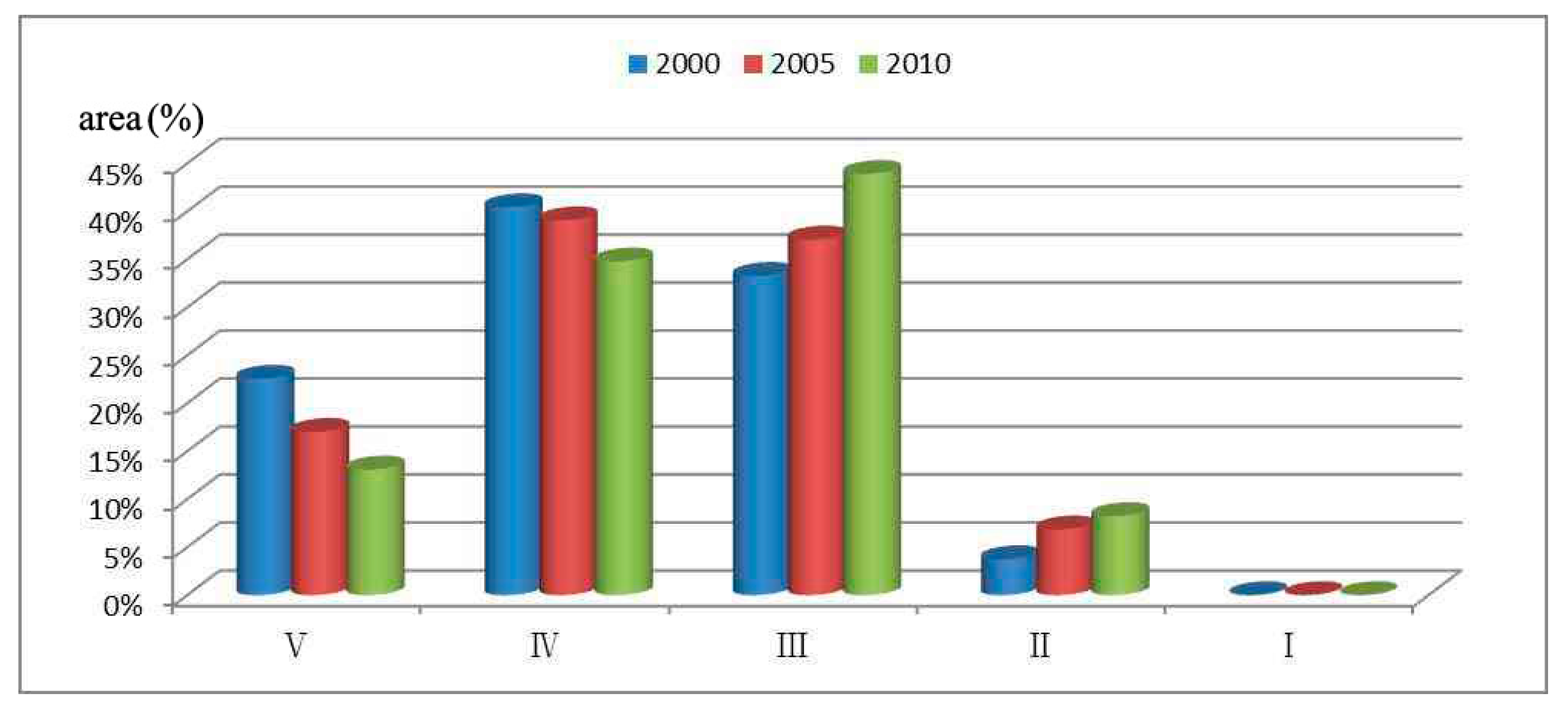
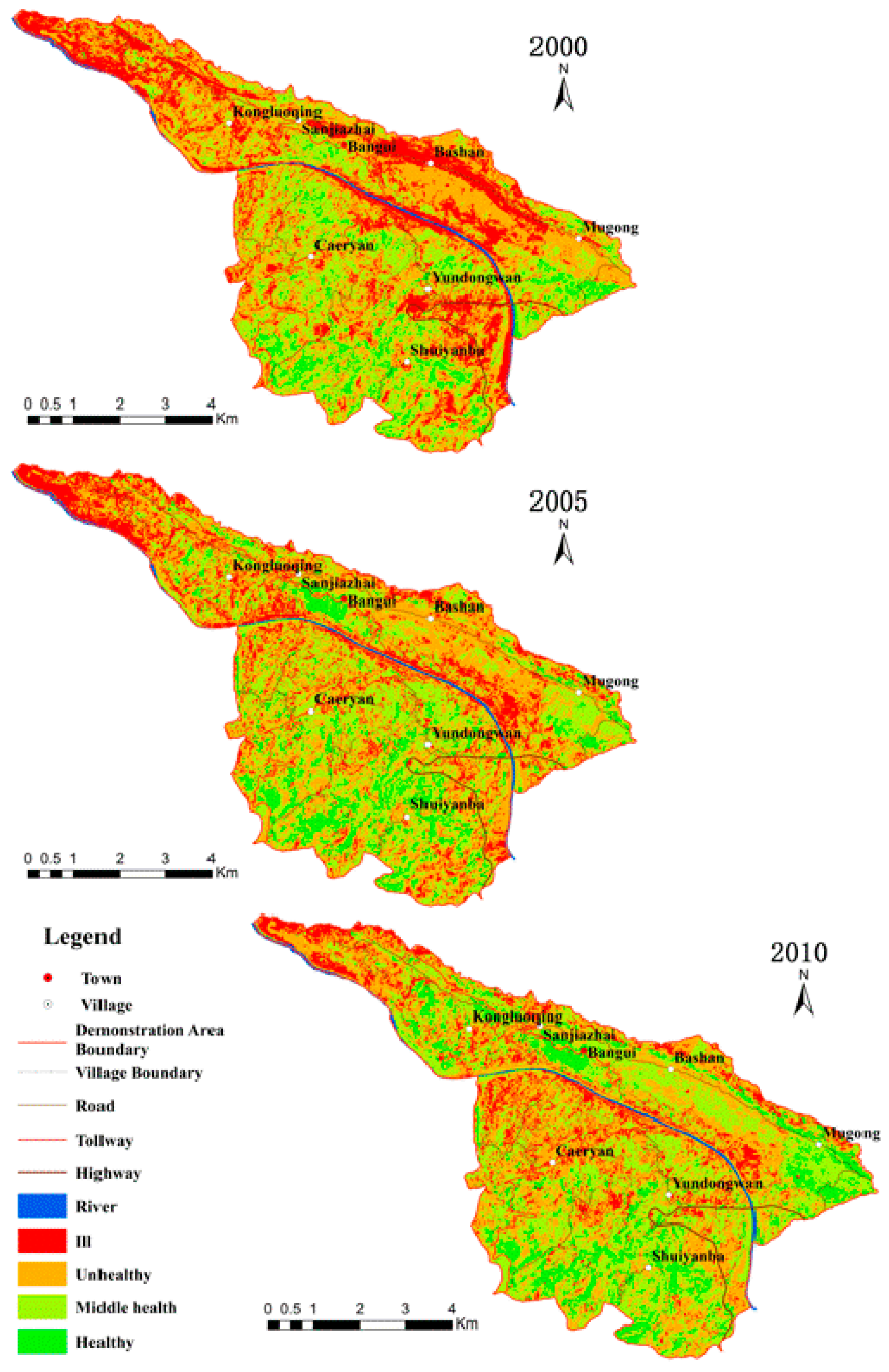
| Level | Ecosystem Health Index (K) | State | Characteristics of Ecosystem Health Index (K) |
|---|---|---|---|
| I | >4 | Excellent Health | High level of structural integrity, stability, and sustainability; perfect ecological function; none or nearly no negative impact from external human and/or non-human factors; no abnormalities; high resilience. |
| II | (3, 4] | Healthy | Moderate level of structural integrity, stability, and sustainability; high ecological function; slight negative impact from external human and/or non-human factors; no abnormalities; moderate resilience. |
| III | (2.5, 3] | Middle Health | Marginal level of structural integrity, stability, and sustainability; degraded ecological functioning; noticeable levels of human disturbance; low resilience. |
| IV | (2, 2.5] | Unhealthy | Low level of structural integrity, stability, and sustainability; degraded ecological functioning; significant human disturbance; low resilience |
| V | ≤2 | Ill | Extremely poor structural integrity, stability, and sustainability; highly degraded ecological functioning; severe human disturbance; very low resilience |
| Object (Level A) | Aspects B | Element C | Indicators D | Data Sources | Weight E |
|---|---|---|---|---|---|
| Ecological system health diagnosis in rocky desertification area | Geologic support system | Geology | Lithology | Geologic map | 0.0297 |
| Terrain | Altitude | DEM data | 0.0218 | ||
| Slope | DEM data | 0.0315 | |||
| Climate | Annual precipitation | Monitoring data | 0.0392 | ||
| Soil | Land use | RS + GIS + DEM data | 0.0978 | ||
| Environmental support system | Vitality | Vegetation coverage | RS + GIS + Monitoring data | 0.0899 | |
| Coefficient of cultivated land | RS + GIS + The basic geographic data | 0.0512 | |||
| Organization | Soil erosion | RS + GIS + Monitoring data | 0.0848 | ||
| Landscape Diversity Index | RS + GIS + The basic geographic data | 0.0699 | |||
| Rocky desertification grades | RS + GIS + Monitoring data | 0.0943 | |||
| Restoring force | Comprehensive control of KRD | RS + GIS + Monitoring data | 0.1398 | ||
| Socio-economic support system | Economics | Per capita GDP | Field survey data | 0.0345 | |
| Population | Population density | Field survey data | 0.0641 | ||
| Education level | Population characteristics | Field survey data | 0.0321 | ||
| Human interference | Hemeroby Index | RS + GIS + basic geographic data | 0.1194 |
| Indicator | Diagnosis Value, Evaluation Standard, Standard Classification | ||||
|---|---|---|---|---|---|
| 9, I, Excellent Health | 7, II, Healthy | 5, III, Middle Health | 3, IV, Unhealthy | 1, V, Ill | |
| Lithology | T3ls | T3wy | T2lt4 | T2lt3 | T2yl |
| Altitude (m) | 500–650 | 650–850 | 850–1050 | 1050–1250 | 1250–1400 |
| Slope (°) | <8 | 8–15 | 15–25 | 25–35 | >35 |
| Annual precipitation (mm) | 1300–1400 | 1200–1300; >1400 | 1100–1200 | 1000–1100 | <1000 |
| Land use | Forest, River and lake | Woodland, Grass, Paddy field | Dryland, Garden | Residential land, Roadway | Industrial and mining area, rock |
| Vegetation coverage | >0.75 | 0.6–0.75 | 0.45–0.6 | 0.3–0.45 | <0.3 |
| Landscape Diversity Index | >2.5 | 2–2.5 | <2 | - | - |
| Soil erosion | No erosion | Mild erosion | Moderate erosion | Intense erosion | Very intense erosion |
| Rocky desertification degree | Non-Karst area, No rocky desertification | Potential rocky desertification | Mild desertification | Moderate desertification | Strong rocky desertification |
| Coefficient of cultivated land | <10 | 10–20 | 20–35 | 35–50 | >50 |
| Comprehensive control of KRD | - | Conservancy area Forest for soil and water conservation | Fruit forest zones Protection forest | Terraced plowing Planting grass | No project area |
| Per capita GDP (¥ *) | >4500 | 3500–4500 | 2500–3500 | 1500–2500 | <1500 |
| Population density (people per km2) | <100 | 100–150 | 150–200 | 200–250 | >250 |
| Population characteristics (person) | >25 | 20–25 | 15–20 | 10–15 | <10 |
| Hemeroby Index | Not interference <0.1 | Light disturbance 0.1–0.39 | Moderate disturbance 0.4–0.59 | Disturbance intensity 0.6–0.79 | Pole strength interference 0.8–1 |
| Rank | Ecological Health Diagnosis | In 2000 | In 2005 | In 2010 | ∆ * 2000–2005 (%) | ∆ * 2005–2010 (%) | ∆ * 2000–2010 (%) | |||
|---|---|---|---|---|---|---|---|---|---|---|
| Area (km2) | Proportion (%) | Area (km2) | Proportion (%) | Area (km2) | Proportion (%) | |||||
| Ⅰ | Excellent health | 0 | 0 | 0 | 0 | 0 | 0 | 0 | 0 | 0 |
| Ⅱ | Healthy | 1.9 | 3.7 | 3.5 | 6.8 | 4.2 | 8.2 | 3.1 | 1.4 | 4.5 |
| Ⅲ | Middle health | 17 | 33.2 | 19 | 37.1 | 22.5 | 43.9 | 3.9 | 6.8 | 10.7 |
| Ⅳ | Unhealthy | 20.7 | 40.4 | 20 | 39.1 | 17.8 | 34.8 | −1.3 | −4.3 | −5.6 |
| Ⅴ | Ill | 11.6 | 22.7 | 8.7 | 17 | 6.7 | 13.1 | −5.7 | −3.9 | −9.6 |
© 2016 by the authors; licensee MDPI, Basel, Switzerland. This article is an open access article distributed under the terms and conditions of the Creative Commons Attribution (CC-BY) license (http://creativecommons.org/licenses/by/4.0/).
Share and Cite
Chen, S.; Zhou, Z.; Yan, L.; Li, B. Quantitative Evaluation of Ecosystem Health in a Karst Area of South China. Sustainability 2016, 8, 975. https://doi.org/10.3390/su8100975
Chen S, Zhou Z, Yan L, Li B. Quantitative Evaluation of Ecosystem Health in a Karst Area of South China. Sustainability. 2016; 8(10):975. https://doi.org/10.3390/su8100975
Chicago/Turabian StyleChen, Shengzi, Zhongfa Zhou, Lihui Yan, and Bo Li. 2016. "Quantitative Evaluation of Ecosystem Health in a Karst Area of South China" Sustainability 8, no. 10: 975. https://doi.org/10.3390/su8100975





